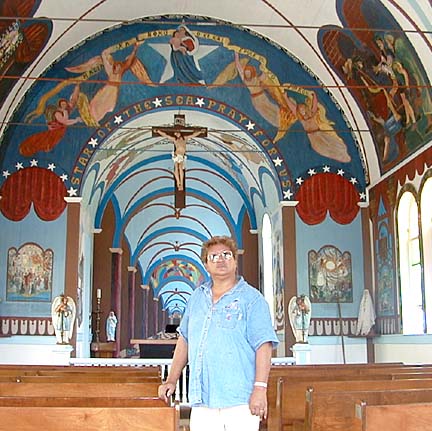


Shrine in decline KALAPANA, Hawaii >> Glowing in sunlight by the side of Highway 130, the former Star of the Sea Catholic Church looks sturdy and maybe even safe from damage since its move from the path of oncoming lava in 1990.
The Kalapana painted church
escaped lava in 1990, but time has
caught up with its unique artworkBy Rod Thompson
rthompson@starbulletin.comBut the community group now caring for the building -- informally called the "Kalapana painted church" -- says it is in danger of losing its luster.
"From a distance, it looks like, wow!" said Noelani Ing, a docent with the Kalapana Ohana Association. "When you come up close and look at it, there's a lot of work that needs to be done."
The term "painted church" refers to religious scenes painted on the interior.
Belgian-born Father Evarist Gielen completed the wooden church in 1931, then spent his nights painting scenes from a now nearly forgotten catechism book.

Association President Mabel Wilson says her father, Edmund Kaawaloa, assisted Gielen, who said he did his best work by candlelight. "No disturbances, no noise -- he could concentrate," Wilson said.Gielen painted the upper walls of the church in subdued colors using house paints and linseed oil. In 1961 historian Alfred Frankenstein wrote, "He seems particularly to have liked a resonant gray."
In 1964, after Gielen moved to Maui, George Heidler, described as a "hitchhiker" or "drifter," but with artistic talent, painted more scenes in brighter colors on the lower walls.
In 1975 parishioners invited the retired Gielen, 77, back from Maui to celebrate his 50th anniversary in the priesthood. Church historian Father Louis H. Yim described events just before Gielen returned to Maui.
"A shocking incident took place. Without a word to anyone, the old priest went into the church with a can of light blue paint and covered over Heidler's painted scenes on the church walls." A few of Heidler's scenes were spared.
Later, a third painter, George Lorch, added paintings in a detailed, miniaturist style over Gielen's blue paint.

Postcards from the 1950s show major deterioration that was later touched up, but the paintings are again suffering.Docent Ing indicates the white paint of the vaulted ceiling. "On a daily basis, I can come in here and find dripped (flecks of) paint. It happens regularly," she says.
A wooden window frame is separating from colored glass panes. Vibrant scenes are marred by cracked and blotchy paint.
Paint is also blistering off the exterior, and spots of wood are rotting.
After the building was saved from lava in 1990, it sat unprotected on wooden blocks for six years. In 1996 it was moved to its present site on three acres of state land leased to the association for 65 years.
To ensure preservation, the association listed the building on the state Register of Historic Places. It was a tradeoff, since repairs that once could have been done by the community must now be researched and done by experts.
To pay for repairs, the association will hold a hoolaulea fund-raiser on Sept. 15. Other money comes from a donation box and the sale of kulolo coconut candy made in an imu oven behind the church.
The association wants to hold weddings at the former church to make money. It is getting requests already but has not worked out details.
Behind the building, the association is also creating the Father Damien Hawaiian Cultural Center.
But the former church remains central. "This is our piko, our navel," Ing said. "This is the beginning of life right here."